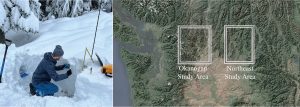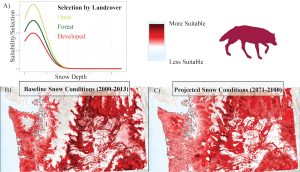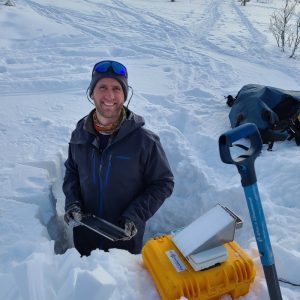A Shifting Snowpack Links Climate Change with Wildlife Habitat Selection in the Northeast Cascades
by Ben Sullender, UW School of Environmental and Forest Sciences, PCC Graubard Graduate Fellow
Climate change is rapidly reshaping what winter looks like in the Pacific Northwest. In maritime climates like western Washington, much of the seasonal snowpack accumulates in temperatures near freezing, so even a slight increase in temperature could switch winter precipitation from snow to rain. Colder, higher elevations, on the other hand, might maintain or even gain more snow as we get more precipitation in the winter. Where, when, and how much snow accumulates is critical for wildlife that rely on snow for shelter, for forage access, and for synchronizing life-history events like migration.
Thanks to support from the Program on Climate Change’s Graubard Fellowship, I’ve been able to dive into these questions, quantifying the impact of climate change on snow and then linking these snow conditions with wildlife distribution. In part because snow varies so much, both across a landscape and throughout a winter, I’ve used field measurements to better understand snow conditions in two study areas in Washington state: the Okanogan and Northeast. These areas straddle mountain ranges and include great habitat for a variety of large mammals including mule deer (Odocoileus hemionus), white-tailed deer (O. virginianus), cougars (Puma concolor), and wolves (Canis lupus).

Researchers at the Washington Department of Fish & Wildlife and the University of Washington fit a number of these large mammals with collars that recorded GPS locations from 2017-2022 as part of the Washington Predator-Prey Project. This location data lets us map how animals respond to snow conditions throughout the winter. I tracked these large mammals across our study areas, measured how much they sink into the snow and determined which snow properties (density, snow surface hardness, how much ice was present, and other variables) most strongly affect how they move. My measurements served a dual purpose: I could also build up a network of snow observations to see how snow varies across the landscape.
Because our study areas were too large to effectively sample snow everywhere, we had to fill in the gaps with snow model output. For this, we used SnowClim, a physically-based snow model that used weather information like temperature and wind speed to calculate how a snowpack “evolves” or changes over time. By aggregating snow conditions over time, we got a sense of what a typical baseline snowpack might look like, and then – importantly – tweaked these input weather data to match likely climate change scenarios. We linked wildlife habitat selection patterns with snow conditions during the baseline time period, and then applied these same models to a forecasted future time period. This allowed us to see how habitat suitability might change as a direct result of our changing snowpack.

Our preliminary results indicate that wildlife respond strongly to both snow conditions and landcover. Wolves, for example, tend to avoid urban and developed areas and prefer open areas to forests. However, wolves will avoid any areas with snow depths greater than 2 m (6 feet), regardless of landcover type (Figure 2A). Because wolves prefer moderate snow depths (around 40 cm or 1.5 feet), the reduced snow in climate change projections may open up additional habitat at higher elevations while decreasing habitat suitability at lower elevations (Figure 2B and 2C). Whether their preferred prey species – ungulates including mule deer and white-tailed deer – follow these same patterns remains to be seen. We plan to further investigate how prey distribution interacts with snow conditions to create suitable predator habitat.
 Ben is a 3rd year Ph.D. student in the School of Environmental and Forest Sciences and a past member of the PCC Graduate Steering Committee. His Ph.D. research explores the connections between snow conditions, predator-prey interactions, and climate change.
Ben is a 3rd year Ph.D. student in the School of Environmental and Forest Sciences and a past member of the PCC Graduate Steering Committee. His Ph.D. research explores the connections between snow conditions, predator-prey interactions, and climate change.